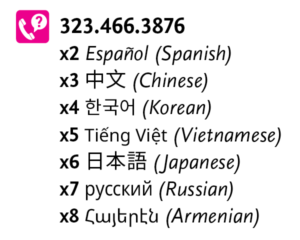Home > About Metro > Gentrification and Displacement
Gentrification and Displacement
Metro has a plan to enhance the quality of life in LA for everyone. It includes increasing access to opportunity by connecting everyone to what they need most. Metro also recognizes investment can sometimes bring unintended consequences and/or make existing problems worse in our local communities.
What are gentrification and displacement?
The Urban Displacement Project defines gentrification as “a process of neighborhood change in a historically disinvested neighborhood…by means of real estate investment.” This definition also includes the changes that happen when new, higher-income residents move in, altering the demographics of the neighborhood in terms of race and education level of residents.
Displacement , as also defined by The Urban Displacement Project, is “when housing or neighborhood conditions actually force moves.” This displacement can be physical or economic, based on deteriorating buildings or rising housing costs. “Exclusionary Displacement” is when these factors prevent certain types of people from moving in to begin with.
Low-income residents are also more likely to experience the negative impacts of gentrification, primarily displacement from the homes, businesses and services that build their community.
How do gentrification and displacement relate to Metro?
Metro has a strong interest in ensuring that the people who ride public transportation can afford to live near it. Residents who live within a half mile of a transit station and earn less than $25,000 each year are three times more likely to take transit than those who earn more than $75,000 each year and live close by. Research shows that 73 percent of Metro riders make less than $25,000 annually. In order for Metro to serve the majority of its riders, it must support low-income communities to directly benefit from transit investments and corresponding community revitalization.
What is Metro doing to support, protect and stabilize communities?
With a commitment to support all communities in benefitting from transit investments, the Metro Board of Directors adopted the Transit Oriented Communities (TOC) Policy and the Equity Platform.
The TOC Policy formalized the importance of incorporating land use and community development considerations in Metro’s planning and delivery of transit infrastructure. The policy acknowledges that Metro does not have regulatory land use control, nor authority to directly enact policies that support equitable development. Given this, the policy encourages partnerships with local municipalities, community-based organizations and a range of stakeholders to enable and incentivize realization of the TOC goals:
- Increase transportation ridership and choice
- Stabilize and enhance communities surrounding transit
- Engage organizations, jurisdictions and the public
- Distribute transit benefits to all
- Capture value created by transit
The Equity Platform is grounded in planning for equity from the start of all Metro efforts, with deep community engagement. It includes four pillars:
- Define and measure
- Listen and learn
- Focus and deliver
- Train and grow
Metro also established a series of programs where we can directly support the protection and creation of affordable housing and small businesses:
- The Joint Development Policy sets a goal that 35 percent of housing built on Metro-owned property will be affordable to households making 60 percent of the Area Median Income or less. Currently, 36 percent of all units built on Metro-owned land are required to be rated as affordable units. For projects in the pipeline, 46 percent of units are proposed to meet these requirements.
- The MATCH (Metro Affordable Transit Connected Housing) program leverages $9 million in Metro funds with about $50 – $60 million in additional funds from foundations and lenders for the protection and production of affordable housing in low-income communities near high-quality transit nodes. Of the loan, 75 percent will support protection of naturally occurring affordable housing and 25 percent will support new affordable housing.
- Metro’s Business Interruption Fund grants up to $50,000 to small businesses impacted by the Purple Line Extension construction, Regional Connector construction in Little Tokyo and along the Crenshaw/LAX Transit Project. To date, Metro has awarded more than 840 grants with a total grant value of $20 million.
- Metro’s TOC Small Business Loan Fund has invested $1 million in a loan fund targeting small and local businesses. The focus is to help establish these businesses in vacant commercial spaces near transit.
Beyond these existing programs and policies, Metro is currently developing the TOC Implementation Plan to establish a series of programs and projects, along with metrics, that will further expand Metro’s efforts to address displacement of low-income households, strengthen opportunities for small and local businesses, and preserve and enhance communities’ cultural assets. Because Metro does not have regulatory land use control, this plan recognizes Metro’s leading role and the strong need to partner with other entities to realize Metro’s TOC goals.
Contact Us

Scroll Spy here
